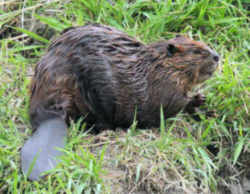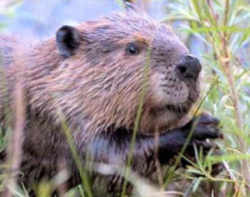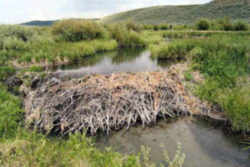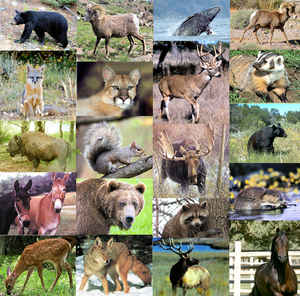Oregon State Animal
American Beaver

(Castor canadensis)
Adopted in 1969.
The American Beaver, (Castor canadensis, )was named Oregon state animal by the 1969 Legislature. Prized for its fur, the beaver was over trapped by early settlers and eliminated from much of its original range. Through proper management and partial protection, the beaver has been reestablished in watercourses throughout the state and remains an important economic asset. The beaver has been referred to as "nature's engineer," and its dam-building activities are important to natural water flow and erosion control.
Oregon State Animal: American Beaver

Besides man, the beaver is one of the few animals that can change their environment to benefit themselves. They are master dam builders, pooling deep water behind dams that are typically four or five feet high. Occasionally dams exceed three hundred feet long, and one record dam in Montana was 2,140 feet long. Beaver carry branches in their teeth or wedged between their front legs and chest. They also carry mud between their front feet and chest. The branches and mud are wedged into any area where water flows until a solid dam is completed.
Oregon is known as the "Beaver State" and Oregon State University's athletic teams are called the "Beavers."
Characteristics of the Oregon Beaver

The beaver is a large, semi-aquatic rodent with a large, flattened tail. Beavers are about 3 ft (0.9 m) long; their flat, thick tail is about 1 ft (30 cm) long. They weigh 30-70 pounds (14-32 kg). Like all rodents, their teeth continue to grow their entire lives. Their ears and nostrils can close while the beaver is underwater. While swimming, transparent eyelids protect their eyes. Beavers can close their mouth by closing a flap located behind their teeth, allowing them to chew while holding their breath. It is a strong swimmer and can swim up to 5 miles per hour (8 kph). The beaver can swim underwater for up to 15 minutes. Young beavers are called kits. Beavers live in forests in North America and in parts of Europe and Asia. Beavers do not hibernate over winter, but they will stay in their lodge, where they have stored enough food to last until spring.
Diet
Beavers are herbivores (plant-eaters). They eat tree bark, leaves, roots, twigs, and water plants. Their favorites include willow, maple, poplar, beech, birch, alder, and aspen trees. They also eat water vegetation as well as buds and roots. Cellulose, which usually can not be digested by mammals, is a major component of their diet. Beavers have microorganisms in their cecum (a sac between the large and small intestine) that digest this material.
Reproduction
Female beavers are sexually mature at 2.5 years old. They give birth to one litter of kits per year, usually between April and July. The gestation period is about 3 months. The litter usually consists of 4 kits, but up to 8 are possible. They are born with all of their fur, their eyes open, and their incisor teeth erupted.
The young usually stay with their parents for 1-2 years and then leave to make their own homes.
(Frazier, 1996; Sevilleta LTER, 1995)
Predators
The beaver is hunted by many animals, including coyotes, wolves, bears, lynxes, and wolverines. Minks, owls and hawks prey upon young beavers. Beavers cannot move very quickly on land, so their best defense from predators is to retreat into the water and go into their lodge.
Lodges and Dams
Beavers build sophisticated lodges out of sticks and mud. The dome-shaped lodge is built in water and only has underwater entrances. If the local pond water isn't deep enough, the beaver will build a dam (or a series of dams) downstream from where the beaver wants to build a lodge. The dam forms a deep pond. Beavers cut down trees for the dam using their strong teeth. The water in the pond must be deep enough so that the pond bottom won't freeze in winter, blocking the lodge's entrance.
Behavior
Beavers form monogamous pairs and usually live in family groups of up to 8 related individuals called colonies. The younger siblings stay with their parents for up to 2 years, helping with infant care, food collection, and dam building.
Beaver families are territorial and defend against other families. In order to warn each other of danger, beavers slap their tails against the water, creating a powerful noise.
Beavers are primarily nocturnal. They are only occasionally seen during the day. They usually wake at dusk.
Beavers travel good distances from their homes to find food. If they find a good source, they build canals to the food source as a way to float the food back to their lodges. Logs and twigs are stored underwater for winter feeding.
(Hall and Kelson, 1959; Frazier, 1996; Sevilleta LTER, 1995)
Oregon Senate Joint Resolution 1
The resolution was first read in the Senate on January 15, 1969. It was approved by both houses by March 27. Signed by the President of the Senate, E.D. Potts of Grants Pass, on April 3 and the Speaker of the House, Robert F. Smith of Burns, on April 4, Joint Resolution No. 1 was filed with the Secretary of State on April 4, 1969.
SENATE JOINT RESOLUTION 1
Whereas the great and sovereign State of Oregon officially adopted a state seal at its Constitutional Convention in 1857; a state flag in 1859 upon
admission into the Union; a state flower, the Oregon grape, in 1899; a state bird, the Western Meadowlark, by selection of the school children of the
state in 1927; a state tree, the Douglas fir in 1939; a state motto, "The Union", in 1957; a "Father of Oregon", Dr. John McLoughlin,
in 1957; the state colors, navy blue and gold in 1959; a state fish, the Chinoock salmon, in 1961; and a state rock, the Thunderegg, in 1965; and
Whereas the legislature of the State of Oregon in 1925 enacted a law prescribing a state flag and including in the description thereof the provision
that the reverse of the flag should bear the figure of a beaver in gold on a blue field; and
Whereas by inadvertent oversight, neither that body nor any of its predecessors or successors took occasion to enact legislation recognizing the importance
of the Beaver to the history and economy of this state in any other way; and
Whereas this Fifty-fifth Legislative Assembly desires to remedy the aforementioned oversight, and to welcome the Beaver to the family of official symbols
representative of the State of Oregon; now, therefore,
Be it resolved by the Legislative Assembly of the State of Oregon:
That the Beaver (Castor canadensis) hereby is declared to be the official animal of the State of Oregon.
Filed in the office of Secretary of State April 4, 1969.
Oregon Revised Statutes - 2009 Edition, Title 19, Chapter 186.
TITLE 19 MISCELLANEOUS MATTERS RELATED TO GOVERNMENT AND PUBLIC AFFAIRS
186. State Emblems; State Boundary
CROSS-REFERENCES.
Beaver declared to be official animal, SJR 1 (1969)
Taxonomic Hierarchy: American Beaver
Kingdom: Animalia
Phylum: Chordata
Class: Mammalia
Order: Rodentia
Family: Castoridae
Genus: Castor
Species: C. canadensis








